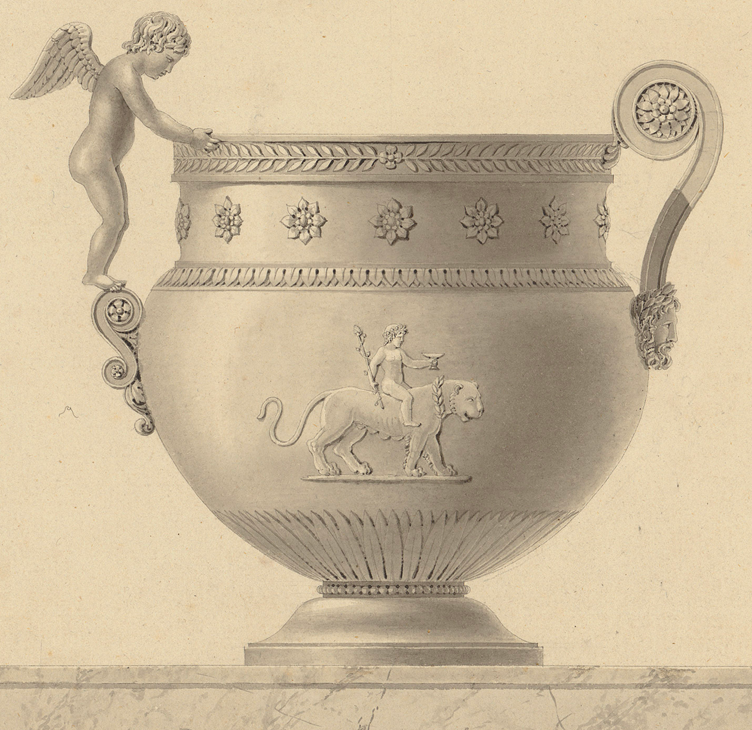Odiot, the finest French goldsmith
Founded in 1690, Odiot goldsmith house gained recognition under Louis XV and the direction of Jean Baptiste Gaspard Odiot who supplied the Royal Court with exceptional pieces of extreme quality and refinement.
Jean Baptiste Claude Odiot, born in 1763, would a few decade after his grand father Jean Baptiste Gaspard Odiot bring the company to excellence and glory under the French Empire which ordered several extraordinary pieces. He first decided to pursue a military career which, even if he later would eventually become a goldsmith, will always be part of his life. From 1781 he learnt to master gold smithery in France, in the workshop of his father, Jean Claude Odiot and completed his apprenticeship in England. In 1785, at the age of 22 he officially became a goldsmith and in 1785 his mark bearing his initials JBCO.
Odiot Hallmark
© Odiot Paris
His workshop, located located 1 rue de l’Evèque in Paris, quickly developed and in 1807 counted 50 workers. Odiot managed to reduce the cost to produce his pieces thanks to a savvy ornament system which was automated. In numerous of his creations, he therefore used the cold assembling technique where different ornaments would be screwed on the pieces which would eventually become one of his signatures.
Jean-Baptiste-Claude Odiot
Bottom view of a French Empire parcel-gilt silver double salt-cellar
©Bukowskis
Drawing his inspiration from the antiquity and especially from Greek, Roman mythological and animal figures such as Bacchus, Hébé, Cérés, Léda, Vénus, Dolphins, Sphinxes and so on, the design of his creations was strongly aligned with the overall taste of his period. The figure of Bacchus, God of vineyards and wines, is prominent in Odiot’s work since it was particularly suited for the creation of tableware pieces. Snakes, swans, mermaids were often used to create the handles of his pieces while foots were most of the time taking the form of winged Sphinxes and tigers’ claws.
Jean-Baptiste-Claude Odiot
Cruet frame (one of a pair)
ca. 1817
Silver gilt, glass
© MET Museum
In 1801 he participated to the creation of the consular sword of the emperor which would be later used during his Napoléon Sacre in 1804. One year later, In 1802, his participation during the National Exhibition of Industrial Products is a great success for him and the organization rewarded him with a gold medal. Quickly Odiot’s name circulated not only in France but across the different European royal courts who would soon also place orders from the House.
The first step necessary to produce a silver piece is drawing. Even though Odiot surely knew how to draw, until now no drawing bearing his signature have been found since he used to collaborate and resort to other artists overseeing creating the preparatory drawings for his pieces. Among the artist who draw for him are Pierre Paul Prud’huon, Auguste Garneray, allegedly Percier & Fontaine and many more who remain unknown.
Sugar Bowl Drawing
Jean-Baptiste-Claude Odiot workshop, circa 1815
© MAD, Paris
From drawings, sculptors would then create models in wax, plaster or terracotta from which mould were made. Talented sculptors could be found working alongside Odiot such as Henri-Victor Roguier, Verniat, Brunet, Desprez or Thomire. The latter met Odiot in 1804 but it seems that they their collaboration really started from 1810 when creating the Toilette of the Empress Marie Louise (this exceptional piece would eventually be destroyed in 1836). In 1811, both artists would partner again together on the occasion of the creation of the King of Rome cradle as well as several pieces for the cabinet for the Emperor at the Tuileries.





